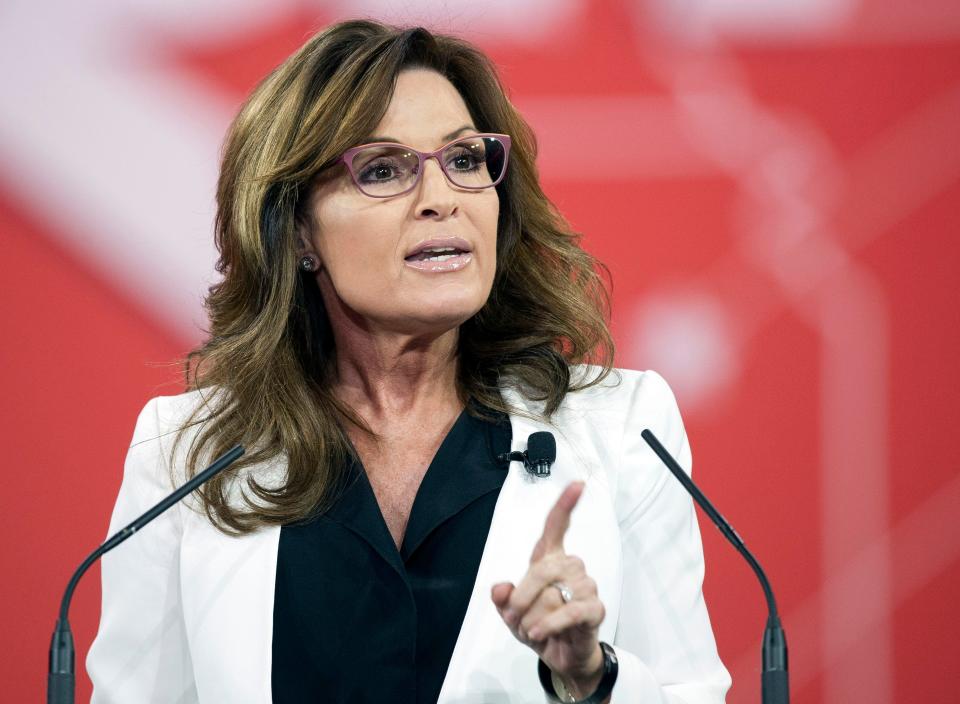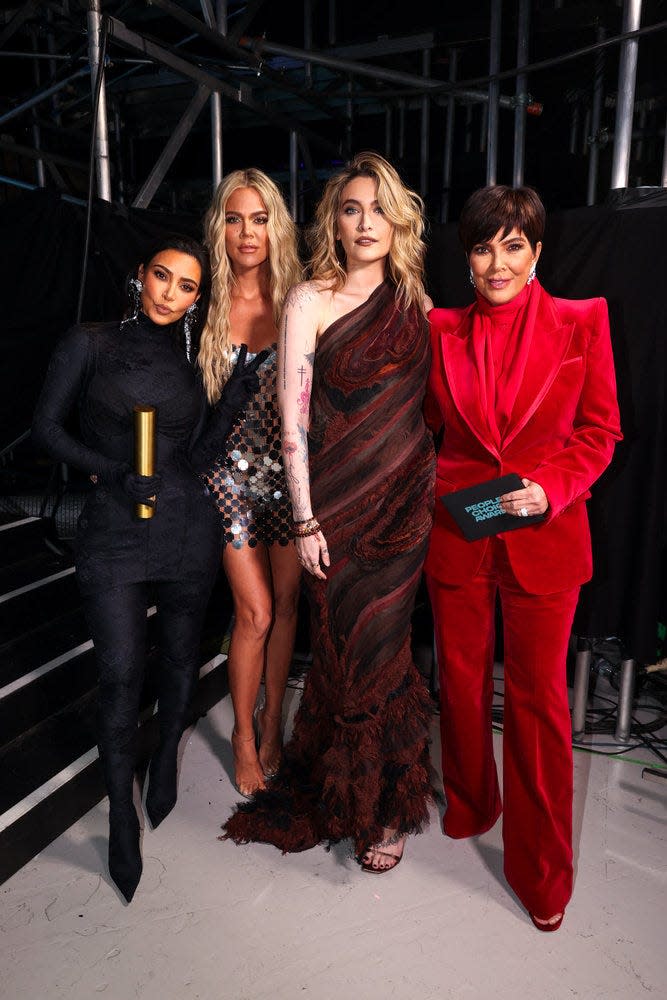Sarah Palin v. New York Times rightly questions media defamation protections
- Oops!Something went wrong.Please try again later.
- Oops!Something went wrong.Please try again later.
For those of us who teach torts, we are living in the golden age of defamation. Since President Donald Trump took office, a long litany of fascinating libel and slander cases have been filed against or threatened by an array of politicians and celebrities, from Duchess Meghan to MyPillow CEO Mike Lindell to former Rep. Devin Nunes, R-Calif.
Most recently, after numerous efforts to dismiss the case, The New York Times found itself in court defending an editorial that bizarrely appeared to blame former Alaska Gov. Sarah Palin for the 2011 shooting of then-Rep. Gabrielle Giffords, D-Ariz. On Tuesday, the jury ruled against her.
The judge stated his intention Monday to dismiss the case regardless of the jury's verdict. After criticizing The Times for its false attack on Palin, Judge Jed Rakoff said that he was "not at all happy to make this decision" but had no choice because of the "very high standard" set by the Supreme Court in such cases involving public figures.
Rakoff might, however, have just created the ideal case for the Supreme Court to change that standard on appeal.
The editorial, “America’s Lethal Politics,” came after the shooting of GOP Rep. Steve Scalise, R-La., and other members of Congress by James Hodgkinson, 66, apparently a supporter of Sen. Bernie Sanders, I-Vt. The 2017 attack did not fit with a common narrative in the news media of right-wing violence, and The Times rushed to put out an editorial deflecting from the association.
It said Palin's political action committee posted a graphic that put Giffords' district in crosshairs before she was shot. The editorial stated, "The link to political incitement was clear." It was false, but the claim was used to spin the shooting of Republican members: “Though there’s no sign of incitement as direct as in the Giffords attack, liberals should of course hold themselves to the same standard of decency that they ask of the right.”
More from Jonathan Turley: 3 officers face federal charges in Floyd death. Guilt hinges on proving 'willful' violation.
The Times later issued a correction, and the jurors were given the case before the judge ultimately decided he would dismiss regardless of what they concluded – a rather curious approach. Many believe that the Times defamed Palin. Yet, even if the Times falsely portrayed Palin's map, that does not mean Palin could have prevailed.
The problem is that Palin is a “public figure” and – under controlling Supreme Court precedent of New York Times v. Sullivan and later cases – must shoulder a higher burden of proof. In other words, The Times can defame her and still prevail.
Protecting journalistic inquiry
The Palin case comes at a time when the seminal defamation case, Times v. Sullivan, is under attack not just from Trump but also a couple of Supreme Court justices.

Six decades ago, Justice William Brennan wrote arguably his most eloquent and profound decision, in which the court unanimously declared that the First Amendment required a higher standard of proof for defamation than simple negligence for public officials.
Opinions in your inbox: Get a digest of our takes on current events every day
News outfits were being targeted at the time by anti-segregation figures in lawsuits to deter them from covering the civil rights marches. The court correctly saw civil liability as creating a chilling effect on the free press either by draining them of funds or inducing a type of self-censorship. Imposing a high standard for proof of defamation, Brennan sought to give the free press “breathing space” to carry out its key function in our system.
The court believed that public officials have ample means to rebut false statements, but that it's essential for democracy for voters and reporters to be able to challenge government officials. To achieve that breathing space, the court required that public officials had to prove “actual malice,” where the defendant had actual knowledge of the falsity of a statement or showed reckless disregard whether it was true or false.
Putting the press on the defensive
Recently, two justices indicated that they might be open to the idea of revisiting New York Times v. Sullivan. Justice Clarence Thomas has been a long critic of the standard as unsupported in either the text or history of the Constitution. Thomas and Justice Neil Gorsuch objected last year to the denial of certiorari in Berisha v. Lawson, in which author Guy Lawson published a book detailing the “true story” of three Miami youngsters who allegedly became international arms dealers.
The CIA is at it again: The CIA might be collecting data about you. Here's why that's wrong and why you should care.
It was a success and landed a movie deal. A central figure in the story was Shkelzen Berisha, the son of Albania’s former prime minister. He sued Lawson for defamation and claimed that he was not, as portrayed, an associate of the Albanian mafia and that Lawson used unreliable sources for his account.

Berisha is a public figure rather than a public official. As such, he fell under the same standard because the court previously found that celebrities should have to meet the same burden. It noted that celebrities are powerful in our celebrity-driven culture, have ample means at their disposals to protect themselves and chose their lives of notoriety.
The problem is that there is one missing element to imposing a higher burden on public figures like Berisha: furthering the democratic process. In teaching defamation, the actual malice standard rests convincingly on a democratic rationale that a free people and free press must have breathing space to criticize the government and their leaders. It helps protect and perfect democracy.
Why punish private citizens?
For 30 years, I have struggled in class to offer the same compelling rationale for applying the standard to anyone who is considered a public figure. It takes very little to qualify as a public figure, or a "limited-purpose public figure.” However, why should private success alone expose someone like the Kardashians to a higher burden of proof for defamation? Writing about hot-dog-eating champion Michelle Lesco does not protect core democratic principles or even support core journalistic principles. To succeed, a Kardashian would still have to prove that a statement was false and unreasonable to print. Moreover, publications are protected in most states by retraction statutes limiting or blocking damages for corrected stories. Finally, opinion is already protected from defamation actions.

Clearly, the current standard still allows some public figures to maintain actions for defamation. Palin won an important pretrial challenge in her lawsuit against The Times in 2020.
There are difficult questions that warrant serious discussion not only on the court but also in society. For example, there may be a more credible basis for imposing a higher standard on public figures on subjects of great public interest. However, what constitutes a legitimate public matter, particularly when that matter is based on a false account?
Take Nicholas Sandmann, who was pulled into a vortex of coverage due to the false claim that he abused an elderly Native American activist in front of the Lincoln Memorial. Sandmann has secured settlements for the biased and false reporting of major media outlets. Defamation still protects opinion without the reliance on a higher constitutional standard for figures like Sandmann.
Clearly, the public figure standard is an obvious benefit to the media. However, without a compelling argument for a constitutional standard for public figures, it seems more like a judicially maintained subsidy or shield. The purpose of Times v. Sullivan was not to simply prop up the press. The Palin case and other cases could present a new opportunity for the court to review the doctrine.
When Justice Sonia Sotomayor recently denounced the “stench” of politics that followed the addition of her three newest colleagues to the court, she warned, “We won’t be able to survive if people believe that everything, including New York v. Sullivan, (is) all political.”
What we really need is an airing out – not of the constitutional standard but its application to non-public officials.
Jonathan Turley is the Shapiro Professor of Public Interest Law at George Washington University and a member of USA TODAY’s Board of Contributors. Follow him on Twitter: @JonathanTurley
You can read diverse opinions from our Board of Contributors and other writers on the Opinion front page, on Twitter @usatodayopinion and in our daily Opinion newsletter. To respond to a column, submit a comment to letters@usatoday.com.

This article originally appeared on USA TODAY: Palin v. New York Times lawsuit dismissed due to actual malice

